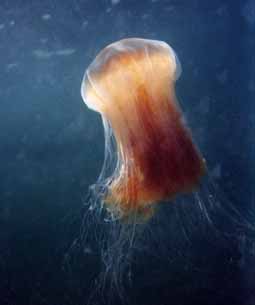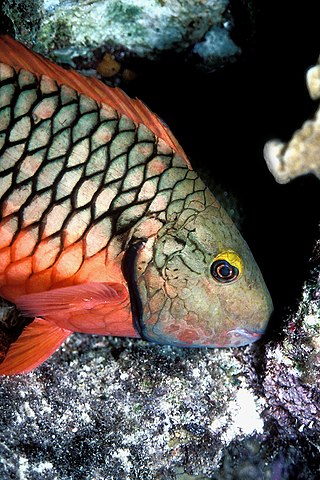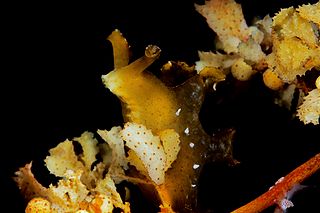
Scyliorhinus is a genus of catsharks in the family Scyliorhinidae. This genus is known in the fossil records from the Cretaceous period, late Albian age to the Pliocene epoch.

Carcharodon is a genus of sharks within the family Lamnidae, colloquially called the "white sharks." The only extant member is the great white shark. The extant species was preceded by a number of fossil (extinct) species including C. hubbelli and C. hastalis. The first appearance of the genus may have been as early as the Early Miocene or Late Oligocene.

Siphonophorae is an order within Hydrozoa, which is a class of marine organisms within the phylum Cnidaria. According to the World Register of Marine Species, the order contains 175 species thus far.

Rhizostomae or Rhizostomeae is an order of jellyfish. Species of this order have neither tentacles nor other structures at the bell's edges. Instead, they have eight highly branched oral arms, along which there are suctorial minimouth orifices. These oral arms become fused as they approach the central part of the jellyfish. The mouth of the animal is also subdivided into minute pores that are linked to coelenteron.

The Cyaneidae are a family of true jellyfish. About 20 species are in this family, including the well-known lion's-mane jellyfish.

Sparisoma is a genus of parrotfishes native to warmer parts of the Atlantic. FishBase recognizes 15 species in this genus, including S. rocha described from Trindade Island in 2010 and S. choati described from the East Atlantic in 2012. They are the most important grazers of algae in the Caribbean Sea, especially since sea urchins, especially Diadema, the other prominent consumers of algae, have been reduced in many places by a recent epidemic.

Synodus is a genus of fish in the family Synodontidae found in Atlantic, Indian, and Pacific Oceans.

Planorbis is a genus of air-breathing freshwater snails, aquatic pulmonate gastropod mollusks in the family Planorbidae, the ram's horn snails, or planorbids. All species in this genus have sinistral or left-coiling shells.

Anisus is a genus of small air-breathing freshwater snails, aquatic pulmonate gastropod mollusks in the subfamily Planorbinae of the family Planorbidae, the ramshorn snails and their allies.

Porpita porpita, or the blue button, is a marine organism consisting of a colony of hydroids found in the warmer, tropical and sub-tropical waters of the Pacific, Atlantic, and Indian oceans, as well as the Mediterranean Sea and eastern Arabian Sea. It was first identified by Carl Linnaeus in 1758, under the basionym Medusa porpita. In addition, it is one of the two genera under the suborder Chondrophora, which is a group of cnidarians that also includes Velella. The chondrophores are similar to the better-known siphonophores, which includes the Portuguese man o' war, or Physalia physalis. Although it is superficially similar to a jellyfish, each apparent individual is actually a colony of hydrozoan polyps. The taxonomic class, Hydrozoa, falls under the phylum Cnidaria, which includes anemones, corals, and jellyfish, which explains their similar appearances.
Tritonium is a genus of sea snails, marine gastropod mollusks in the family Cancellariidae, commonly known as the nutmeg snails.

Simnia is a genus of sea snails, marine gastropod mollusks in the family Ovulidae.

Bothus is a genus of flatfish in the family Bothidae from the Pacific, Indian and Atlantic Oceans. Some species in this genus have spots consisting of blue rings.

Nepa is a genus belonging to the family Nepidae, known as water scorpions. There are six species found in freshwater habitats in the Northern Hemisphere.

Olindiidae is a family of hydrozoans in the order Limnomedusae. They have a polyp phase and a medusa phase. The polyps are generally small (1 mm) and solitary, but a few species are colonial. They have a varying number of tentacles and can reproduce by budding. In the largest species, the medusae can grow to 15 cm (6 in). Centripetal canals may be present or absent and the radial canals are unbranched. The gonads are beside the radial canals, except in Limnocnida, where they are on the manubrium. The fertilised eggs develop into planula larvae which become polyps. These multiply asexually or can bud off medusae. In some species, medusae are only produced when the water temperature exceeds a certain level. Most species are marine, but several can also be found in brackish water and a few, notably Craspedacusta and Limnocnida, are found in fresh water.

Eudendrium is a large genus of hydroids (Hydrozoa), one of two in the family Eudendriidae. These animals are marine cnidarias in the family Eudendriidae.

Scyllaea is a genus of nudibranchs. They are marine gastropod molluscs in the family Scyllaeidae.

Haemulon is a genus of fish in the grunt family known as the scaled-fin grunts. Most are found in the western Atlantic Ocean, with a few species known from the eastern Pacific Ocean. This genus is considered to be one of the most important fish groups of the coral reefs of Brazil due to its commercial value and crucial ecological role.

Sertulariidae is a family of hydrozoans.

Schizaster is a genus of heart urchins belonging to the family Schizasteridae. The type species of the genus is Schizaster studeri.


















